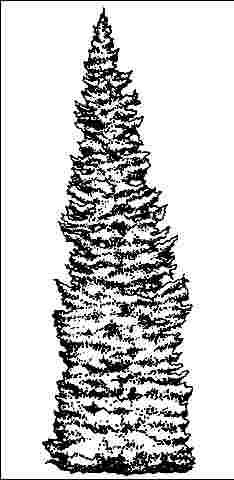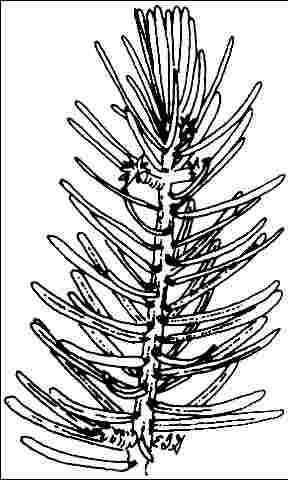Picea omorika: Serbian Spruce1
Introduction
A narrow, pyramidal silhouette with thin, graceful arching branches. The trunk grows straight and the tree requires no pruning to keep the narrow, pyramidal form. The upper surface of the needles is glossy, dark green. The lower surface is marked with two white stomata lines. The plant will grow about 50 feet tall and spread 20 feet and is one of the most elegant Spruces.

General Information
Scientific name: Picea omorika
Pronunciation: PIE-see-uh oh-more-EE-kuh
Common name(s): Serbian Spruce
Family: Pinaceae
USDA hardiness zones: 4A through 7B (Fig. 2)
Origin: not native to North America
Invasive potential: little invasive potential
Uses: specimen; screen; tree lawn > 6 ft wide; highway median
Availability: somewhat available, may have to go out of the region to find the tree

Description
Height: 45 to 50 feet
Spread: 15 to 20 feet
Crown uniformity: symmetrical
Crown shape: pyramidal
Crown density: moderate
Growth rate: slow
Texture: fine
Foliage
Leaf arrangement: alternate (Fig. 3)
Leaf type: simple
Leaf margin: entire
Leaf shape: needle-like (filiform)
Leaf venation: parallel
Leaf type and persistence: evergreen, needled evergreen
Leaf blade length: less than 2 inches
Leaf color: green
Fall color: no color change
Fall characteristic: not showy

Flower
Flower color: unknown
Flower characteristics: not showy
Fruit
Fruit shape: oval, elongated, cone
Fruit length: 1 to 3 inches
Fruit covering: dry or hard
Fruit color: brown
Fruit characteristics: does not attract wildlife; not showy; fruit/leaves not a litter problem
Trunk and Branches
Trunk/bark/branches: branches droop; not showy; typically one trunk; thorns
Pruning requirement: little required
Breakage: resistant
Current year twig color: brown
Current year twig thickness: medium, thick
Wood specific gravity: unknown
Culture
Light requirement: full sun, partial sun or partial shade
Soil tolerances: clay; sand; loam; slightly alkaline; acidic; well-drained
Drought tolerance: moderate
Aerosol salt tolerance: low
Other
Roots: not a problem
Winter interest: no
Outstanding tree: yes
Ozone sensitivity: unknown
Verticillium wilt susceptibility: resistant
Pest resistance: resistant to pests/diseases
Use and Management
This tree is best used as a specimen, wind break, screen, or perhaps as an evergreen street tree for narrow overhead spaces. It is surprisingly tolerant of urban conditions, probably more so than other Spruces. Grows best with some shelter from mid-day or afternoon sun, though it tolerates full-day sun. Also tolerates soils with a high pH.
Pests
Bagworms make a sack by webbing needles and debris together. Small numbers may be picked off by hand or use Bacillus thuringiensis . Usually not serious.
In northern areas, Spruce budworm larvae feed on developing buds and young needles. The yellowish brown caterpillars are difficult to see.
The Spruce needle miner makes a small hole in the base of a needle then mines out the center. Dead needles are webbed together and can be found on infested twigs.
Spider mites can be problem in summer after hot dry weather. The small insects can't be readily seen with the naked eye. The first noticeable symptoms are yellowing of the oldest needles on infested branches. Close inspection with a magnifying glass will confirm the presence of the mites.
Sawfly larvae may feed on the needles. One infestation will usually not kill the tree.
Diseases
Spruce may be attacked by needle casts causing needles to turn yellow or brown and drop off. Another needle cast affects the lowest needles first then moves up the tree. Infected needles are a mottled yellow.
Several rust diseases attack Spruce but these are rarely seen. Infected needles turn yellow and drop off.


